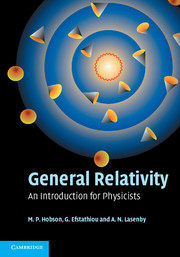Book contents
- Frontmatter
- Contents
- Preface
- 1 The spacetime of special relativity
- 2 Manifolds and coordinates
- 3 Vector calculus on manifolds
- 4 Tensor calculus on manifolds
- 5 Special relativity revisited
- 6 Electromagnetism
- 7 The equivalence principle and spacetime curvature
- 8 The gravitational field equations
- 9 The Schwarzschild geometry
- 10 Experimental tests of general relativity
- 11 Schwarzschild black holes
- 12 Further spherically symmetric geometries
- 13 The Kerr geometry
- 14 The Friedmann–Robertson–Walker geometry
- 15 Cosmological models
- 16 Inflationary cosmology
- 17 Linearised general relativity
- 18 Gravitational waves
- 19 A variational approach to general relativity
- Bibliography
- Index
12 - Further spherically symmetric geometries
Published online by Cambridge University Press: 05 September 2012
- Frontmatter
- Contents
- Preface
- 1 The spacetime of special relativity
- 2 Manifolds and coordinates
- 3 Vector calculus on manifolds
- 4 Tensor calculus on manifolds
- 5 Special relativity revisited
- 6 Electromagnetism
- 7 The equivalence principle and spacetime curvature
- 8 The gravitational field equations
- 9 The Schwarzschild geometry
- 10 Experimental tests of general relativity
- 11 Schwarzschild black holes
- 12 Further spherically symmetric geometries
- 13 The Kerr geometry
- 14 The Friedmann–Robertson–Walker geometry
- 15 Cosmological models
- 16 Inflationary cosmology
- 17 Linearised general relativity
- 18 Gravitational waves
- 19 A variational approach to general relativity
- Bibliography
- Index
Summary
In the preceding three chapters, we have considered in some detail the Schwarzschild geometry, which represents the gravitational field outside a static spherically symmetric object. We also considered the structure of the Schwarzschild black hole, in which the empty-space field equations are satisfied everywhere except at the central intrinsic singularity. In this chapter, we consider solving the Einstein equations for a static spherically symmetric spacetime in regions where the presence of other fields means that the energy–momentum tensor is non-zero. In particular, we will concentrate on two physically interesting situations. First, we discuss the relativistic gravitational equations for the interior of a spherically symmetric matter distribution (or star); in this case the energy–momentum tensor of the matter making up the star must be included in the Einstein field equations. Second, we consider the spacetime geometry outside a static spherically symmetric charged object; once again this is not a vacuum, since it is filled with a static electric field whose energy–momentum must be included in the field equations.
The form of the metric for a stellar interior
Most stars in the sky are nowhere near dense enough for general-relativistic effects to be important in determining their structure. This is true for main sequence stars (of which our Sun is an example), red giants and even such high-density objects as white dwarfs.
- Type
- Chapter
- Information
- General RelativityAn Introduction for Physicists, pp. 288 - 309Publisher: Cambridge University PressPrint publication year: 2006



